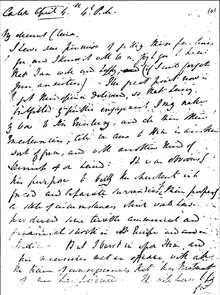Handwriting
|
|
This article is written like a personal reflection or essay rather than an encyclopedic description of the subject. (April 2011) |
|
|
This article needs additional citations for verification. (April 2011) |
Handwriting is a person's particular and individual style of writing with pen or pencil. Handwriting is distinct from from "Hand" or script which is any impersonal and formalised writing style in several historical varieties.


Contents[hide] |
[edit] Uniqueness of Individuals' Handwriting
Every literate human has her or his own manner of writing. There are many peculiarities in a handwritten text:
- specific shape of letters, e.g. their roundness or sharpness;
- regular or irregular spacings between letters;
- the slope of the letters;
- the rhythmic repetition of the elements or arrhythmia;
- the pressure to the paper;
- the average size of letters;
- and many others.
Handwriting is relatively stable, i.e. the style of writing changes slowly with age.[citation needed] Another important fact is that all people have different handwriting. Even identical twins have differences.[1] Therefore, the most common type of questioned document examination involves handwriting wherein the examiner tries to address concerns about potential authorship.
[edit] Inferences From Handwriting Samples
The handwriting can contain some other information. For example, you can find out whether a person was nervous or intoxicated at the time of the sample.
[edit] Graphology
Graphology is the pseudoscientific study and analysis of handwriting in relation to human psychology. In the medical field, it can be used to refer to the study of handwriting as an aid in diagnosis and tracking of diseases of the brain and nervous system.[citation needed]
[edit] Bad Handwriting
Handwriting is considered bad if it prevents other people from being able to read the copy. Some people think that many doctors have bad handwriting. According to "Time", doctors' sloppy handwriting kills more than 7,000 people annually.[2] However, D. Berwick and D. Winickoff showed that "the handwriting of doctors was no less legible than that of non-doctors" and that "significantly lower legibility than average was associated with being an executive and being male"[3] Bad handwriting can be a symptom of disease. For example, dopamine-responsive dystonia has the following symptoms (among others):
- near normal handwriting in infants/kindergarten years. (ages 3–5 school)
- poor handwriting in pre-teens years. (ages 8–11 school)
- very poor (worse) handwriting during teens years. (qv secondary school)
- bad handwriting (worsening) during post-teens years. (qv university exams)
- very bad handwriting (still worsening) during adult years. (qv post-graduate exams)
- worsening pattern of sloppy handwriting best observed by school teachers via termly reports.
[edit] References
- ^ Sargur Srihari, Chen Huang and Harish Srinivasan. On the Discriminability of the Handwriting of Twins. J Forensic Sci. 2008 Mar;53(2):430-46. http://www.cedar.buffalo.edu/~srihari/papers/TR-04-07.pdf
- ^ Caplan, Jeremy (2007-01-15). "Cause of Death: Sloppy Doctors". TIME. http://www.time.com/time/health/article/0,8599,1578074,00.html. Retrieved 2012-01-06.
- ^ Donald M Berwick, David E Winickoff. The truth about doctors' handwriting: a prospective study. BMJ 313 : 1657 (Published 21 December 1996) http://www.ncbi.nlm.nih.gov/pmc/articles/PMC2359141/pdf/bmj00573-0093.pdf